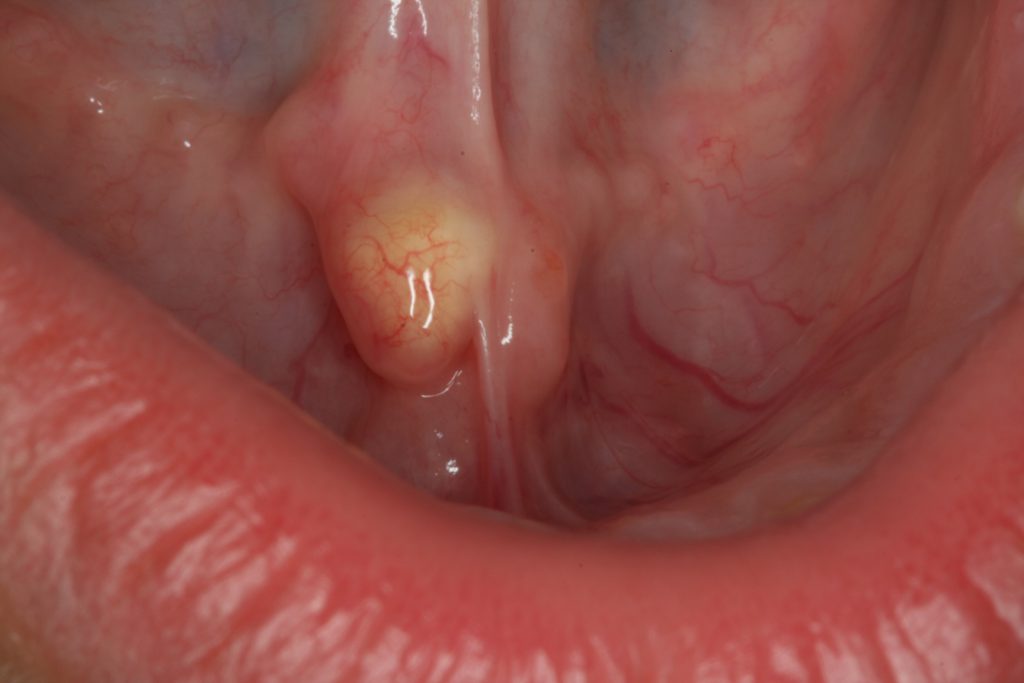Salivary Stones
What are salivary stones?
Salivary Stone, also called sialoliths, are calcified organic masses that form within the salivary gland’s secretory system. Salivary stone comprises organic and inorganic materials, including calcium carbonates and phosphates, cellular debris, glycoproteins, and mucopolysaccharides [1].
Salivary Stone Formation Stages: Decreased saliva flow → deposits settle in walls of salivary duct → flow of saliva slowed → deposits of calcium, phosphorus → forms small concretions (micro-stone)→ grow into stone → stones block the duct. And when bacteria move from the mouth up, around the blockage, into salivary duct → inflammation, tissue swelling (sialadenitis secondary to stone).
What are the etiological factors for salivary stone formation?
The following are some of the etiological factors for salivary stone formation [2]:
- Abnormal narrowing of the salivary gland duct
- Salivary gland inflammation or infections
- Dehydration
- Medications (i.e., antidepressants, anticholinergics, antispasmodics, antihistamines, antihypertensives)
- Saliva composition (i.e., calcium saturation)
- A deficit of crystallization inhibitors (i.e., phytate)
Which salivary gland is more susceptible to stone formation and why?
Salivary stones occur most commonly in the submandibular glands (80%–90%), followed by the parotid (5%–15%) and sublingual (2%–5%) glands, and only very rarely occur in the minor salivary glands.
The higher rate of stone formation in the submandibular gland is due to [3]:
- The submandibular duct (Wharton’s duct) is longer than other salivary ducts. That means that saliva secretions travel further before being discharged into the mouth.
- The tortuous duct course. The Wharton’s duct possesses two curves, at the posterior border of the mylohyoid muscle and near the duct orifice.
- The flow of saliva from the submandibular gland is often against gravity due to the location of the duct orifice is higher than the gland
- The submandibular gland orifice itself is smaller than that of the parotid.
What are the salivary stones symptoms?
In general, the degree of symptoms depends on the extent of salivary duct obstruction and if there is a secondary infection.
Patients with salivary stones most commonly present with:
- The most common patients complaint is salivary gland swelling upon eating. This swelling happens because the stone entirely or partially blocks the flow of saliva.
- Patients also might complain of pain. Since the glands are encapsulated, and there is little space for expansion, the saliva’s retention will cause pain unless the stone is small and does not significantly saliva retention.
- The gland’s swelling will subside when salivary stimulation ceases, and saliva is secreted out of the gland. Depend on the stone’s size, and this may take few minutes to few hours.
- As described in the formation of the stone section above, stasis of the saliva may lead to the inflowing of bacterial into the gland causing infection, fibrosis, and gland atrophy.
- There may be expressible suppurative or nonsuppurative drainage and erythema or warmth in the overlying skin if there is a concurrent infection.
What are the clinical steps to diagnose salivary stones?
- The first step is bimanual palpation directed in a posterior to anterior fashion along the course of the involved duct, and it may be possible to detect a stone.
- Plain film radiographs are helpful to visualize stones. But the question is they are inexpensive, readily available, and result in minimal radiation exposure.
Can salivary stone detect on plain radiography? It is essential to understand that fifty percent of parotid gland stones and 20% of submandibular gland stones are poorly calcified [4]. This is clinically significant as these poorly calcified stones will not be detected radiographically.
- Conventional sialography: a catheter will be inserted through the duct opening oil, or water-based iodine contrast will be instilled. Then imaging using panoramic, CBCT, CT images, or MRI will be used. Sialolith will look like a void in the sialography image.
- Ultrasound: is widely used as a first-line imaging modality to assess the presence of salivary gland stone. It is safe as no radiation is involved in the modality, less costly than other imaging, and can visualize large stones.
- CT images have higher sensitivity than plain film radiography for detecting salivary stones using a slice thickness of 0.2– 0.5 mm.
- CBCT can be used, and it has the advantages of reduced superimpositions and distortions of the panoramic image and reduced radiation exposure over medical CT.
- Sialendoscopy can be used as a diagnostic and therapeutic technique for salivary gland stones. Its advantages include allowing visualization of the duct canal and segments of a duct and removing stone if possible.
How is salivary stone treated?
- Treatment starts with managing the acute phase using analgesics, hydration, and antipyretics, as necessary.
- If the stone is noticed near the duct’s orifice and it has a small size, sialogogues such as sugarless lemon troches, massage, and heat applied to the affected area may also be beneficial to eject the stone outside.
- Big stones or the stones located in the posterior portion of the duct can be removed by surgery.
- Small stones can be removed by sialendoscopy
- Sialoadenectomy remains the last treatment option in case of failure of refractory intraparenchymal stones.

References
- Huoh, K.C. and D.W. Eisele, Etiologic factors in sialolithiasis. Otolaryngol Head Neck Surg, 2011. 145(6): p. 935-9.
- Liu, B., et al., Xerostomia and salivary hypofunction in vulnerable elders: prevalence and etiology. Oral Surg Oral Med Oral Pathol Oral Radiol, 2012. 114(1): p. 52-60.
- St. Louis, M., Contemporary Oral, and Maxillofacial Surgery. Mosby Elsevier. pp. 398, 407–409, 2008.
- Haring, J.I., Diagnosing salivary stones. J Am Dent Assoc, 1991. 122(5): p. 75-6.
